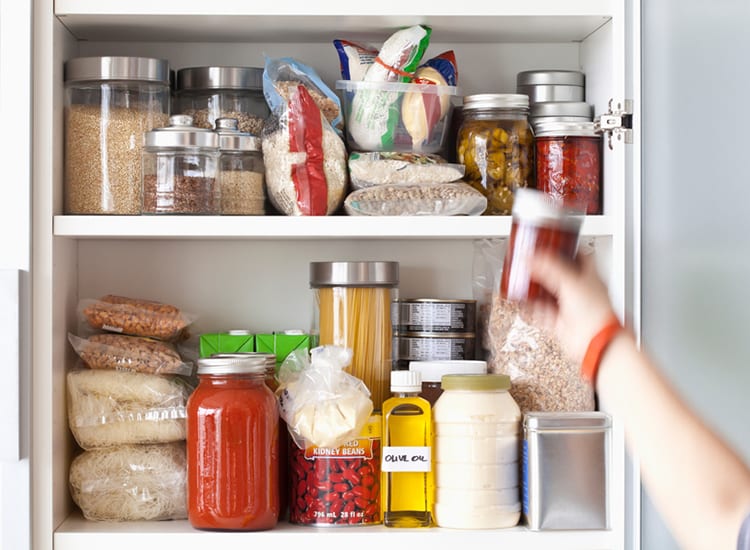Clean 21 Day Gut Health Cleanse
Our Signature 21-Day Full-Body Reset for Longevity
Questions? Ask about this product
Free Shipping On Orders Over $50
Complementary products


Healthy eating, at its core, is based on whole, natural foods. This includes fresh fruits and vegetables, legumes, grains, nuts, seeds, herbs, spices, and high-quality animal proteins. These pantry staples are budget-conscious and focus on healthful eating.
The truth is, yes, when you buy fresh-pressed juices and dairy-free, gluten-free, sugar-free cookies, the grocery bill will go up. However, these things aren’t always essential. If cost is a concern right now, stick to the basics, and add the other fun items in occasionally.
Here is our list of Clean-approved pantry staples that are great to have on hand.
Lentils and beans are a great plant-based, inexpensive source of protein. Try experimenting with different kinds to see which ones you like best.
● Lentils
● Chickpeas
● Black beans
● Cannellini beans
● Mung beans
● Grain-free pastas – chickpea pasta, lentil pasta, and black bean pasta are all great, tasty options to satisfy that pasta craving and are super wallet friendly.
These are naturally gluten-free grains. Buy in bulk to save some extra money. Some of them are also available as pastas, which can be a nice change.
● Brown rice
● Quinoa
● Millet
● Buckwheat
Buying nuts and seeds in bulk really helps to cut down on the price too! Keep them in the fridge so that they last longer (the oils in them go rancid quickly when exposed to heat).
Nut and seed butters can be expensive and prices vary a lot from store to store. Do your research when it comes to where you should grab yours. Always look for added ingredients here too, like sugar and palm oil (they will sneak in there). If you can, make your own at home!
● Walnuts
● Almonds
● Cashews
● Pumpkin Seeds
● Chia Seeds
● Nut + seed butters
● Unsweetened coconut flakes – A great source of fat and super budget-friendly. Try enjoying by themselves as a snack or using them to top your smoothies.
These all seem kind of expensive upfront. In truth, they will last a while and can be worth the investment. We break down what oils are good for cooking and why in our healthy cooking oils guide.
● Olive oil
● Coconut oil
● Avocado oil
These are great to have around when you can’t/don’t want to buy fresh. They are already cooked, which comes in clutch on those super busy days. Try making your own “tuna salad” with one of these using this recipe!
● Canned wild salmon
● Canned organic chicken
● Coconut milk – Coconut milk is delicious in soups to add “creaminess” without any dairy. It’s also amazing in smoothies and lattes.
● Vegetable broth + Chicken broth – Broths can be cost-friendly and stand as the base for most soups. We like to also use them when we cook veggies, especially for those veggies that take a little longer to cook down. Pour a little bit in a sauté pan in place of oil and voila! If you are looking for a recipe to make your own, we love this veggie broth.
● Daily Shake – This is a staple for us. It contains a unique blend of vitamins, minerals, protein, and fiber to make sure that we are fueled properly for our busy days ahead. One container also contains 28 servings, so it lasts for about a month.
● All the herbs + spices – Herbs and spices are packed with antioxidants, nutrients, minerals and serious healing capabilities. They also pack on flavor while containing nothing but goodness. Get familiar with different herbs and spices to satisfy your palate and change things up so you don’t get bored. We love turmeric, especially.
● Mustard – Most mustards have only a few ingredients. It’s never a bad idea to check the ingredients though! Mustard is great in salad dressings, marinades and dips.
● Vinegars – Make sure when buying balsamic vinegar, apple cider vinegar, and red wine vinegar that these contain no added ingredients. You can use these to make your own marinades and salad dressings, which are both always better to make at home to ensure they are clean.
● Coconut aminos – Coconut aminos is a bit more sweet and less salty than traditional soy sauce, but it is still delicious. A dash here and there helps change the flavor profile of a dish easily.
● Non-alcoholic vanilla extract – Vanilla extract isn’t just for baking! We love it in coconut/almond yogurt, homemade hot chocolate, matcha lattes and even smoothies. A little bit goes a long way.
● Cacao or cocoa powder – Cocoa powder has fewer nutrients in it due to the fact that it is roasted, and not raw like cacao (the fundamental difference between the two). However it is still a great option and much cheaper than cacao powder. It’s perfect to satisfy that chocolate need while being able to control the amount/type of sugar.
● Unsweetened applesauce – This is great for baked goods or to enjoy as a snack/dessert with a sprinkle of cinnamon.
● Teas – Any of your favorites work here. Save on buying tea out, and enjoy it at home! Some of our favorites are matcha, peppermint, echinacea, ginger and hibiscus.
Written by Hannah Aylward
If you enjoyed this article, you might also like Inside Clean: Fridge tour with Hannah